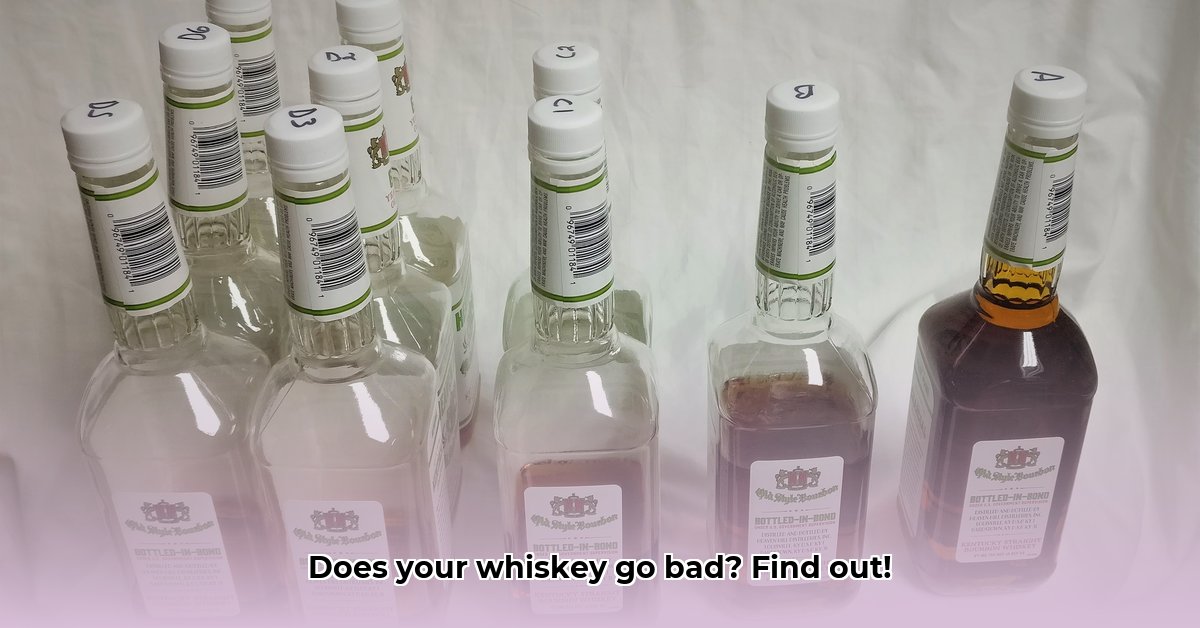Ever wonder if that bottle of whiskey is still good? It’s a question every whiskey lover asks at some point. The answer isn’t a simple yes or no; it depends on a lot of things, with storage playing a significant role in flavor preservation. While we’re discussing preserving the taste of spirits, it’s worth noting that alcohol’s effect on hydration is a common question, so check out this helpful article on alcohol’s effect on hydration. Unopened, whiskey lasts a really long time. But once you open it, things change, and factors like temperature and bottle seal come into play. This guide will teach you everything you need to know about keeping your whiskey tasting its best, from understanding what affects its flavor to how to store it properly. We’ll cover simple steps to protect your collection, whether you’re a beginner or a seasoned collector, so you can enjoy every drop at its peak. We’ll explore ideal storage conditions, examine signs of flavor degradation, and provide expert tips to extend the life of your favorite spirit.
Does Whiskey Go Bad? Understanding Shelf Life
Let’s settle this age-old question: does whiskey go bad? The simple answer is no, not in the sense that it becomes unsafe to drink. Think of it more like a fine spice – it doesn’t spoil, but its flavor definitely changes over time, impacting the overall tasting experience. The real question is, how does that change, and how can you keep your whiskey tasting its absolute best? What specific factors contribute to these changes, and how can we mitigate them to ensure a consistent and enjoyable drinking experience?
Understanding Whiskey’s Long Life and Flavor Evolution
Unopened bottles of whiskey are incredibly stable thanks to their high alcohol content, acting as a natural preservative. Theoretically, they could last for decades, even centuries, if stored in perfect conditions! This is because, unlike wine, whiskey ceases to age once it is bottled. The real challenge arises when you open that bottle, breaking the seal and exposing the spirit to environmental factors. Once the air hits your whiskey, the oxidation process begins, and other elements like light, temperature, and storage practices can directly impact the flavor.
What Affects How Your Whiskey Tastes Over Time?
Several factors influence how quickly your whiskey’s flavor might shift. It’s not a simple yes or no answer – it’s more about understanding the gradual evolution of the flavor profile.
-
The Whiskey Itself: Different whiskeys, due to their unique production processes, age and oxidize differently. The grains used, the distilling process, the type of barrel used for aging (new oak, ex-bourbon, sherry cask, etc.), and the length of aging all play a role in how the whiskey’s flavor will evolve over time. A bourbon, with its typically higher corn content and aging in new charred oak barrels, might change differently than a Scotch, which can use malted barley and age in previously used barrels.
-
Storage Conditions: Storage is paramount. Direct sunlight, temperature fluctuations, and humidity can all accelerate the degradation process. Ideal storage means a cool, dark, and dry environment.
-
The Bottle’s Seal: A good, tight seal (whether a cork or screw top) is crucial for keeping air out, significantly slowing down oxidation. However, not all seals are created equal. Corks, while traditional, can be more prone to drying out or crumbling over time, especially if the bottle is not stored upright. Screw tops generally offer a more airtight seal, but the quality of the seal can still vary.
-
Headspace: The Amount of Air: A nearly empty bottle has a higher proportion of air relative to the whiskey, which dramatically speeds up oxidation. This increased exposure to oxygen can lead to a faster decline in flavor quality.
-
Temperature: Extreme heat or cold can negatively affect the whiskey’s flavor and can even damage the bottle’s seal. High temperatures can cause the whiskey to expand, potentially leading to leaks or a weakened seal. Conversely, very cold temperatures can cause the liquid to contract, potentially drawing air into the bottle if the seal is not perfect.
How Long Does Opened Whiskey Stay Delicious?
While some experts suggest a timeframe of six months to two years before noticeable flavor changes occur, the reality is that it’s a much more gradual shift. The perceived impact varies greatly from person to person; what one individual considers a subtle change, another might not notice at all, or even find appealing. Ultimately, your palate is the ultimate judge. Experiment, taste your whiskeys periodically, and trust your senses.
Proper Storage: The Secret to Keeping Your Whiskey Amazing
The best way to ensure your whiskey stays delicious for as long as possible is through proper storage techniques that minimize oxidation and maintain stable environmental conditions.
-
Cool, Dark, and Dry is Your Mantra: Store your whiskey in a cool, dark place, away from direct sunlight and artificial light, which can wreak havoc on the flavor and impact the overall taste. Consistent temperatures are essential for long-term preservation. A basement, cellar, or even a dark cupboard away from heat sources are ideal locations.
-
Stand Tall: Keep bottles upright, especially those with corks. This ensures that the cork stays moist and prevents it from drying out, shrinking, and letting air in, which can alter the whiskey’s profile. For bottles with screw caps, storing them upright is less critical, but it remains a good practice to prevent any potential leaks.
-
Less Air, More Flavor: If you’ve opened a bottle and there’s a lot of headspace (empty space), consider transferring the remaining whiskey to a smaller, airtight container. This significantly reduces the amount of air interacting with the whiskey, preserving the original flavor for a longer period. Small glass bottles with airtight stoppers or screw caps are ideal for this purpose.
-
Regular Check-Ups: Periodically inspect your bottles, paying close attention to the seal. Look for any signs of cracks, damage, or leakage that might compromise the seal and allow air to enter the bottle. Addressing these issues early can prevent significant flavor degradation.
Understanding the Risks: A Simple Guide
Here’s a quick overview of the potential risks to your whiskey’s flavor and how to mitigate them:
| Risk Factor | Likelihood (Opened Bottle) | Impact on Flavor | How to Minimize the Risk |
|---|---|---|---|
| Oxidation | High | Significant | Minimize headspace, use airtight seals, cool storage |
| Evaporation | Moderate | Moderate | Minimize headspace, use airtight seals |
| Light Exposure | Moderate | Moderate | Store in a dark place |
| Temperature Changes | Moderate | Mild | Consistent temperature storage |
| Seal Failure | Low | Mild | Regular seal checks, proper storage, parafilm |
The Verdict: Does Whiskey Go Bad? (Sort Of)
Unopened whiskey can last an incredibly long time, essentially indefinitely, if stored properly. Once opened, its flavor undergoes gradual changes, which may manifest as slight alterations in color or aroma. While it won’t make you sick, the taste profile will evolve over time. However, by following the simple steps outlined in this guide, you can significantly prolong the time you enjoy your whiskey at its peak. Ultimately, the real question isn’t if it “goes bad,” but rather how to keep it tasting great for longer, allowing you to savor its complex flavors and aromas for months, or even years, to come. Embrace the journey!
How to Prevent Whiskey Oxidation After Opening
Key Takeaways:
- While whiskey’s high alcohol content provides a degree of natural preservation, its exposure to light, air, and temperature fluctuations will inevitably degrade its quality over time.
-
Significant changes aren’t immediate, but noticeable flavor shifts can occur within six months to two years after opening, depending heavily on storage conditions and the specific characteristics of the whiskey itself.
-
Proper storage techniques can significantly extend the drinkable lifespan of your opened whiskey, preserving its intended flavor profile and allowing you to enjoy it at its best.
- The primary concern of oxygen exposure isn’t spoilage, but the loss of delicate aromas and a subtle shift in flavor profile, potentially diminishing the overall drinking experience.
Understanding the Enemy: Oxidation and Evaporation
Let’s be clear: your whiskey isn’t going to spoil like milk. But it will change. The primary culprits responsible for this transformation are oxidation—the interaction of whiskey with oxygen—and evaporation—the slow loss of volatile and flavorful compounds over time. Think of it like a slow leak in a tire, subtly altering the delicate balance of aromas and flavors over time. Lighter, more floral whiskeys are often more susceptible to noticeable flavor changes due to oxidation compared to heavier, more intensely flavored whiskeys like those with smoky or peaty notes.
How does this happen? After opening a bottle, the presence of headspace—the air-filled space between the whiskey and the bottle’s closure—allows air to come into direct contact with the whiskey. Over time, this small amount of oxygen triggers subtle oxidation, a chemical reaction that impacts the volatile aromatic compounds responsible for the whiskey’s distinctive character. Simultaneously, the more volatile components gradually evaporate, further contributing to the changing balance of flavor and aroma.
The speed at which this degradation occurs depends on several factors: the amount of headspace in the bottle, how tightly the bottle is sealed, and the storage conditions. Each factor plays a critical role in determining how quickly the whiskey’s flavor profile will degrade after opening
- Bento Box Trays Streamline Restaurant Meal Presentation and Transport - December 13, 2025
- Plastic Bento Boxes Face Scrutiny Over Sustainability Impacts - December 11, 2025
- Bento Tray Revolutionizes Organized Meal Transport and Presentation - December 10, 2025










